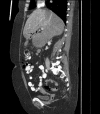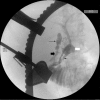Cholecystoduodenal fistula in a patient post-Roux-en-Y gastric bypass
- PMID: 24000218
- PMCID: PMC3794178
- DOI: 10.1136/bcr-2013-200562
Cholecystoduodenal fistula in a patient post-Roux-en-Y gastric bypass
Abstract
We presented a case of a cholecystoduodenal fistula in a patient 4 years post-Roux-en-Y gastric bypass. The patient presented with biliary colic symptoms after a stone became impacted in the fistula and outflow through the cystic duct was intermittently obstructed by a second stone. The fistulous tract was taken down with a cholecystectomy and duodenum repaired with a modified Graham patch.
Figures




References
-
- Iglezias Brandao DO, Adami CE, da Silva BB. Impact of rapid weight reduction on risk of cholelithiasis after bariatric surgery. Obes Surg 2003;2013:625–8 - PubMed
-
- Warschkow R, Tarantino I, Ukegjini K, et al. Concomitant cholecystectomy during laparoscopic roux-en-y gastric bypass in obese patients is not justified: a meta-analysis. Obes Surg 2013;2013:397–407 - PubMed
-
- Nagem R, Lazaro-da-Silva A. Cholecystolithiasis after gastric bypass: a clinical, biochemical, and ultrasonographic 3-year follow-up study. Obes Surg 2012;2013:1594–9 - PubMed
-
- Villegas L, Schneider B, Provost D, et al. Is routine cholecystectomy required during laparoscopic gastric bypass? Obes Surg 2004;2013:206–11 - PubMed
Publication types
MeSH terms
LinkOut - more resources
Full Text Sources
Other Literature Sources
Medical
Research Materials
